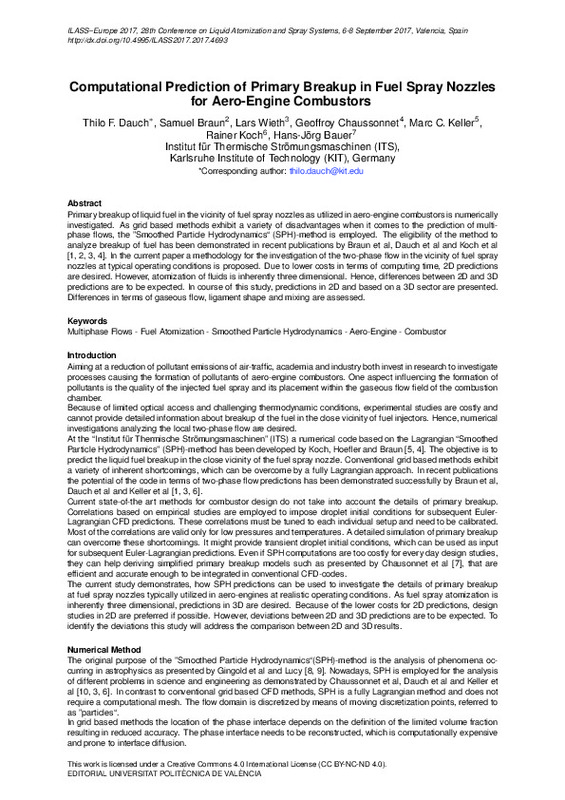JavaScript is disabled for your browser. Some features of this site may not work without it.
Buscar en RiuNet
Listar
Mi cuenta
Estadísticas
Ayuda RiuNet
Admin. UPV
Computational Prediction of Primary Breakup in Fuel Spray Nozzles for Aero-Engine Combustors
Mostrar el registro sencillo del ítem
Ficheros en el ítem
| dc.contributor.author | Dauch, Thilo
|
es_ES |
| dc.contributor.author | Braun, Samuel
|
es_ES |
| dc.contributor.author | Wieth, Lars
|
es_ES |
| dc.contributor.author | Chaussonnet, Geoffroy
|
es_ES |
| dc.contributor.author | Keller, Marc
|
es_ES |
| dc.contributor.author | Koch, Rainer
|
es_ES |
| dc.contributor.author | Bauer, Hans-Jörg
|
es_ES |
| dc.date.accessioned | 2018-04-11T09:38:50Z | |
| dc.date.available | 2018-04-11T09:38:50Z | |
| dc.date.issued | 2017-07-28 | |
| dc.identifier.isbn | 9788490485804 | |
| dc.identifier.uri | http://hdl.handle.net/10251/100178 | |
| dc.description.abstract | [EN] Primary breakup of liquid fuel in the vicinity of fuel spray nozzles as utilized in aero-engine combustors is numerically investigated. As grid based methods exhibit a variety of disadvantages when it comes to the prediction of multiphase flows, the ”Smoothed Particle Hydrodynamics“ (SPH)-method is employed. The eligibility of the method to analyze breakup of fuel has been demonstrated in recent publications by Braun et al, Dauch et al and Koch et al [1, 2, 3, 4]. In the current paper a methodology for the investigation of the two-phase flow in the vicinity of fuel spray nozzles at typical operating conditions is proposed. Due to lower costs in terms of computing time, 2D predictions are desired. However, atomization of fluids is inherently three dimensional. Hence, differences between 2D and 3D predictions are to be expected. In course of this study, predictions in 2D and based on a 3D sector are presented. Differences in terms of gaseous flow, ligament shape and mixing are assessed. | es_ES |
| dc.description.sponsorship | This work was performed on the computational resource ForHLR Phase II funded by the Ministry of Science, Research and Arts Baden-Württemberg and DFG (”Deutsche Forschungsgemeinschaft“). In addition the authors would like to thank Rolls-Royce Deutschland Ltd & Co KG for the outstanding cooperation. The authors also are grateful for many lively and fruitful discussions with Simon Holz. | es_ES |
| dc.format.extent | 8 | es_ES |
| dc.language | Inglés | es_ES |
| dc.publisher | Editorial Universitat Politècnica de València | es_ES |
| dc.relation.ispartof | Ilass Europe. 28th european conference on Liquid Atomization and Spray Systems | es_ES |
| dc.rights | Reconocimiento - No comercial - Sin obra derivada (by-nc-nd) | es_ES |
| dc.subject | Multiphase flows | es_ES |
| dc.subject | Fuel atomization | es_ES |
| dc.subject | Smoothed particle hydrodynamics | es_ES |
| dc.subject | Aero-engine | es_ES |
| dc.subject | Combustor | es_ES |
| dc.title | Computational Prediction of Primary Breakup in Fuel Spray Nozzles for Aero-Engine Combustors | es_ES |
| dc.type | Capítulo de libro | es_ES |
| dc.type | Comunicación en congreso | es_ES |
| dc.identifier.doi | 10.4995/ILASS2017.2017.4693 | |
| dc.rights.accessRights | Abierto | es_ES |
| dc.description.bibliographicCitation | Dauch, T.; Braun, S.; Wieth, L.; Chaussonnet, G.; Keller, M.; Koch, R.; Bauer, H. (2017). Computational Prediction of Primary Breakup in Fuel Spray Nozzles for Aero-Engine Combustors. En Ilass Europe. 28th european conference on Liquid Atomization and Spray Systems. Editorial Universitat Politècnica de València. 806-813. https://doi.org/10.4995/ILASS2017.2017.4693 | es_ES |
| dc.description.accrualMethod | OCS | es_ES |
| dc.relation.conferencename | ILASS2017 - 28th European Conference on Liquid Atomization and Spray Systems | es_ES |
| dc.relation.conferencedate | September 06-08,2017 | es_ES |
| dc.relation.conferenceplace | Valencia, Spain | es_ES |
| dc.relation.publisherversion | http://ocs.editorial.upv.es/index.php/ILASS/ILASS2017/paper/view/4693 | es_ES |
| dc.description.upvformatpinicio | 806 | es_ES |
| dc.description.upvformatpfin | 813 | es_ES |
| dc.type.version | info:eu-repo/semantics/publishedVersion | es_ES |
| dc.relation.pasarela | OCS\4693 | es_ES |
| dc.contributor.funder | Ministerium für Wissenschaft, Forschung und Kunst Baden-Württemberg | |
| dc.contributor.funder | Deutsche Forschungsgemeinschaft |








